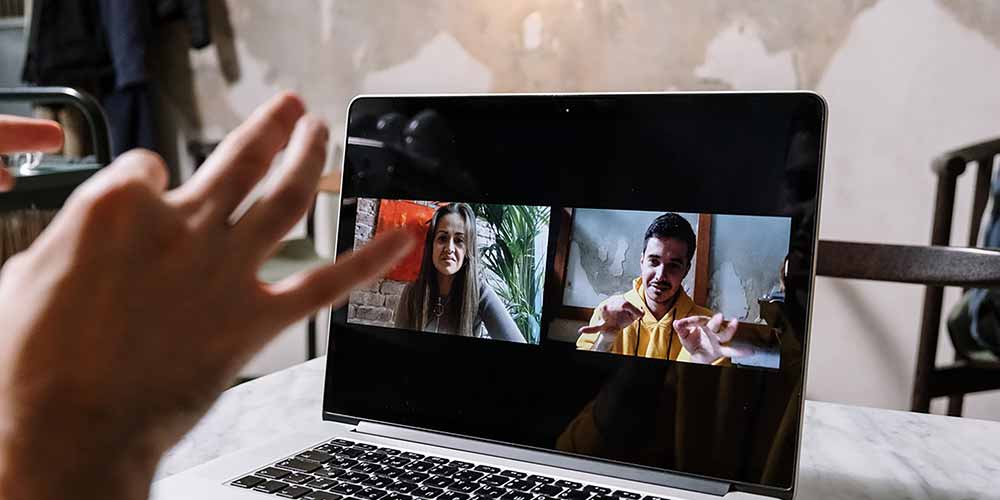Why video off is not on for hybrid work
Is video off bad for business?
We encounter ‘video off’ all too often in meetings and virtual live workshops and our concerns have grown over time. Research we’ve conducted found that others also believe ‘video off’ is having a negative impact on their rapidly changing hybrid workplaces. What was tolerated, via a humane gesture to the COVID shock (including rapidly changed working conditions) that we all suffered, seems to have become a bad habit. It needs urgent and direct addressing, for everyone’s good.
Everything that UGM has learned from decades of experience and study in communication, organisational culture and allied fields suggests that video off is not good for business. As UGM Consulting always does, rather than relying on gut feel alone or our own research, we looked for studies by others that could shed light on the topic. Had we missed findings that suggested video off is generally beneficial in hybrid workplaces?
Video is the current gold standard for telepresence – is that relevant?
First, it’s useful to consider the broader context. Communicating effectively among parties that are not co-located is an age-old problem. Variously, we’ve seen messages sent by any means available: carried on foot by relay runners; transported via relays of horse riders; ferried by pigeons, cars, trucks, trains, ships and planes; and transmitted via analogue technologies, such as smoke signals, flags, flashing lights, telegraph, phonograph, telephone, radio and television.
Most recently, the era of digital communications has dawned, bringing with it the ubiquitous internet. In its broadest conceptualisation, the internet delivers the ability to transfer massive quantities of data over very long distances. This is achieved in almost no time and relatively cheaply. Now, telepresence can be achieved via high-definition video and audio. The negative effects of distance are not yet extinguished but have, in many cases, been significantly mitigated.
Further, reflecting on the value of video into the future, it’s worth noting the forays and investment into virtual reality (VR). Recent breakthroughs in technology and pricing are likely to make this the future gold standard for telepresence (bridging distance). While it’s not yet the teleporting portrayed in science fiction movies (though quantum particles were successfully teleported in 2017), very realistic, real-time, holographic-based communications are not far off, it would seem.
If video doesn’t deliver distinct benefits and value, why are organisations collectively investing trillions into video-based communications technology? They could, at much lower cost, simply stick with their tried-and-true audio-based ‘dial in’ setups and invest no further. Instead, organisations choose not to stick with audio only because there are better options! This, in itself, serves as face validity for the notion that ‘video on’ adds value to most interpersonal communications.
Meta (which has business interests in promoting the adoption of their video solutions) published an article recently with a range of interesting survey findings, highlighting the benefits of video communication. They cited an article in Forbes magazine suggesting that 7 of 10 executives believe that video communication helps their people be more productive.
Other research that Meta cited included a survey showing that 75% of people who use video calls to collaborate remotely said technology enhanced their work-life balance. Also, 89% of those workers believe that using video calls reduces the time it takes to complete a task. It was also revealed that 82% of them were less likely to multi-task on a video call, compared with an audio call. Specially commissioned internal Microsoft research, using both systems metrics and diary entries from participants, found that around a third of the sample were turning their video off in order to multi-task without their colleagues’ knowledge.
Older research, done when teleconferences and dialling in was ‘the latest tech’ showed that multi-tasking while on a call has always been ‘a thing’. Ninety two percent of respondents in one survey mentioned they had multi-tasked during audio-only meetings, with 41% admitting to doing it ‘often or all of the time’. So, while the primary purpose of a video call is to approximate the communication benefits of physical collocation, there is the added advantage of reducing the likelihood that people will multi-task. The real danger when unseen multi-tasking occurs is an erroneous belief that all parties are fully present. When this practice persists in teams over time, it is reasonable to assume that team performance and team cohesion will become casualties.
Recent robust academic quality research is scarce, but supports video on
There seems to be surprisingly little recent, robust, academic, quality research on the differences in team performance among face-to-face, audio only and full video (with sound) communications. One possible reason is that the matter was settled decades ago, even though the best (and hugely expensive) video teleconference facilities were significantly less capable and less available than the technologies of today.
A recent laboratory study, by successful PhD candidate Dr Anthony Baker, examined how face-to-face, audio only and full video modes impacted outcomes of problem-solving tasks in small groups (dyads). In a nutshell, 103 pairs communicated to solve problems using one of the modes being investigated. In the face-to-face mode, one party saw a version of a ‘bomb’ on their computer screen, counting down, and the other party had the bomb disposal instructions but couldn’t see the screen with the bomb on it. In addition to the countdown timer, the device had a range of triggers (or trip wires), such as: having to choose the correct wires and sequence to cut for disarming; a sequence buttons on a panel which needed to be pressed in the right order; and decoding disarming information based on symbols that were flashing on a module. In video mode, parties were connected visually, but one party still could not see the separate screen with the bomb. In the third mode, parties connected via an audio-only call.
Upfront, we recognise that this was a laboratory (not real world) study so it has limitations. The research included a group size of only two (can you imagine how tough things would become for researchers if more people had been involved?). Also, participants tackled specific (really pressured), complicated problems rather than more complex challenges (which are often a lot ‘messier’). All said and done, our professional opinion leads us to conclude that bigger groups and less clearly defined, ‘messy’ challenges would only amplify the impacts found by Baker, rather than diminish them. Here’s what Baker found.
The study concluded that different degrees of virtuality (face-to-face, video or audio) did not significantly affect team task, nor did it affect the team’s perception of communication quality. On their own, those two findings would support video-off moving forward. However, Baker also found that mode of communication significantly impacts levels of trust between the parties. This is an immensely important finding.
Together, Baker points out, these results imply that face-to-face participants (collocated or connected via video) perceive one another as more reliable (even though outcomes were the same), compared with the audio only mode. In the researcher’s words, “seeing a teammate’s face inoculates one against the trust-deteriorating effects of virtuality”. So, even though an audio only channel might deliver similar task outcomes, that mode will likely negatively affect trust.
Profoundly, this means that teams working together over time might be able to deliver outcomes using some audio only communications (phone or video-off). However, to build and sustain trust, which many studies show has a major impact on individual and team performance over the long term, most exchanges should be face-to-face (collocated or connected via video).
How has sentiment to video-off changed over time?
Another consideration in this ‘video on’ or ‘video off’ matter is user sentiment. There is no doubt that ‘use whatever you can, as best you can’ was the catchcry at the start of the pandemic, as billions of people globally shifted from workplace to a home office of some sort. Mindful of the stresses of the pandemic, most people were incredibly tolerant of their colleagues and the demands of the job. But, 20 months down the track, with the new hybrid model taking hold, it is more apparent which general styles of hybrid working are most effective. ‘Video off’ is not one of them!
UGM’s own recent research shows that people are no longer happy with colleagues who always or almost always have their video off. It generally makes communicating a lot more challenging. Those parties with video on end up doing most of the heavy lifting in the communication exchanges – and yes, they are usually more exhausted come the end of the day than those who were unwilling to use their video.
A recent Sydney Morning Herald column captured current negative sentiment around video off with the headline ‘Yes, it’s rude to have your camera off during a video meetings’. The columnist, Dr Kirstin Ferguson, noted that Zoom etiquette has evolved in recent times and now, having video off gives colleagues the impression that you are uninterested, multi-tasking or perhaps not even present. In general, video-off is a no-no.
Our strong advice to management
Taking together the formal laboratory study, as well as our own research, experience and anecdotal evidence, UGM’s strongly recommends that management at the highest levels in organisations mandate ‘video on’ as the default. The business cost of not doing so is just too high.
However, there are likely other cost implications for the organisation, including ensuring that anyone connecting remotely has sufficient quality bandwidth to run good video calls. Also, people should not have to rely only on a small laptop screen while working at home. Repeated studies since 2002 have shown that dual monitors offer an average 42% productivity boost over a single display. The major benefit of a dual monitor for hybrid work is that video can be directed to one screen while another/others apps can be accessed on the second screen.
While many organisations may have to wait some time to renegotiate their office footprint, there are likely to be considerable cost-savings from significantly reducing expensive office space. Since much of that was on a per-person basis, it seems prudent to divert at least some of those savings to ensure staff working remotely have quality access and the technology they need to get the job done.
PRACTICAL IDEAS TO APPLY IN YOUR BUSINESS
5 tips for an effective ‘video on’ approach
- Speak up and say ‘not on’ when people persist in defaulting to ‘video off’!
- Include ‘video on’ as part of your Team Agreement, accepting that occasionally the technology might not work. When this happens, let others know why you’re ‘video off’ and take intentional steps to get back to ‘video on’ status ASAP.
- Schedule meetings in a way that allows you to have a reasonable break / cognitive transition between meetings. That means ditch the ‘no-break-back-to-back’ meetings wherever possible, ideally via diary blocks. Also, ensure you all take short breaks when meetings go on for an extended time.
- Use meditation and mindfulness techniques before and after meetings to capture the demonstrated benefits these techniques offer. Ideally, you’ll make sufficient time between meetings for a couple of minutes of this powerful therapy.
- Turn off your self-video feed, without turning off your video. In this way you won’t be staring at yourself on the screen and the experience will be more like a regular collocated meeting. Zoom has this capability and other platforms are due to release the feature soon.



